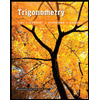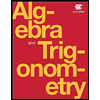A WIN has the coordinates W(-4, 1), I(0, 2) and N(-3, 3). For each series of two transformations, graph the pre-image and the final image. Label all vertices. 4. Reflection over the x-axis followed 5. Translation 3 units right and 6 units down followed by (x, y) → (-x, y) by (x, y) → (x + 5, y + 2) 3 3- 2 -6-5-4-3 -2 -1 -3-2 -1 -2 the Pythagorean Theorem to determine the diagonal distance each figure has traveled ed on the given translation. Round to the nearest tenth if necessary. (rt 11
A WIN has the coordinates W(-4, 1), I(0, 2) and N(-3, 3). For each series of two transformations, graph the pre-image and the final image. Label all vertices. 4. Reflection over the x-axis followed 5. Translation 3 units right and 6 units down followed by (x, y) → (-x, y) by (x, y) → (x + 5, y + 2) 3 3- 2 -6-5-4-3 -2 -1 -3-2 -1 -2 the Pythagorean Theorem to determine the diagonal distance each figure has traveled ed on the given translation. Round to the nearest tenth if necessary. (rt 11
Trigonometry (11th Edition)
11th Edition
ISBN:9780134217437
Author:Margaret L. Lial, John Hornsby, David I. Schneider, Callie Daniels
Publisher:Margaret L. Lial, John Hornsby, David I. Schneider, Callie Daniels
Chapter1: Trigonometric Functions
Section: Chapter Questions
Problem 1RE:
1. Give the measures of the complement and the supplement of an angle measuring 35°.
Related questions
Question

Transcribed Image Text:-5)→ R'(1, 5)
A WIN has the coordinates W(-4, 1), I(0, 2) and N(-3, 3). For each series of two
transformations, graph the pre-image and the final image. Label all vertices.
4. Reflection over the x-axis followed
5. Translation 3 units right and 6 units down
followed by (x, y)→(-x, y)
by (x, y) → (x + 5, y + 2)
5-
3
2
3
2
-5-4-3 -2-1
4 5
6-5 -4 -3 -2
-2
-2
the Pythagorean Theorem to determine the diagonal distance each figure has traveled
ed on the given translation. Round to the nearest tenth if necessary.

Transcribed Image Text:Use the Pythagorean Theorem to determine the diagonal distance each figure has traveled
based on the given translation. Round to the nearest tenth if necessary.
6. (x, y) → (x – 6, y + 8)
7. (x, y) → (x + 11, y – 15)
EdGems Core - Course 3
Lesson 7.2 - Translations
Copyright ©2018 All Rights Reserved
218
Expert Solution
This question has been solved!
Explore an expertly crafted, step-by-step solution for a thorough understanding of key concepts.
This is a popular solution!
Trending now
This is a popular solution!
Step by step
Solved in 2 steps with 1 images

Knowledge Booster
Learn more about
Need a deep-dive on the concept behind this application? Look no further. Learn more about this topic, trigonometry and related others by exploring similar questions and additional content below.Recommended textbooks for you

Trigonometry (11th Edition)
Trigonometry
ISBN:
9780134217437
Author:
Margaret L. Lial, John Hornsby, David I. Schneider, Callie Daniels
Publisher:
PEARSON

Trigonometry (MindTap Course List)
Trigonometry
ISBN:
9781305652224
Author:
Charles P. McKeague, Mark D. Turner
Publisher:
Cengage Learning


Trigonometry (11th Edition)
Trigonometry
ISBN:
9780134217437
Author:
Margaret L. Lial, John Hornsby, David I. Schneider, Callie Daniels
Publisher:
PEARSON

Trigonometry (MindTap Course List)
Trigonometry
ISBN:
9781305652224
Author:
Charles P. McKeague, Mark D. Turner
Publisher:
Cengage Learning


Trigonometry (MindTap Course List)
Trigonometry
ISBN:
9781337278461
Author:
Ron Larson
Publisher:
Cengage Learning